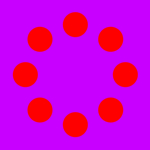 「錯視・注意・脳」
「錯視・注意・脳」
(Visual Illusion, Attention and Brain)
京都大学・こころの未来研究センター・第11回注意研究会
2010年6月25日(金)
 「錯視・注意・脳」
「錯視・注意・脳」
(Visual Illusion, Attention and Brain)
北岡 明佳 (Akiyoshi Kitaoka, 立命館大学 文学部 心理学専攻) email HP
2010/6/10より 講演要旨
Q. What is the illusion?
錯視とは何か?
A. It is a percept different from the properties of an object as it is.
対象の真の性質とは異なる知覚である。
そのとおりなのではあるが・・・これが含蓄が深い。

「立命館湖」
"Lake Ritsumeikan"
立命館大学衣笠キャンパスが水没したように見える。
Copyright A.Kitaoka 2004 (August 14)
ここが水没するようでは京都市街全域水没で~す。もちろん大阪も、神戸も。

偽物/Fake

本物
変化の見落としは錯視か?
Is change blindness an illusion?

"What is changing?"
Only one part keep changing.
Copyright Akiyoshi .Kitaoka 2006 (May 24)

ステレオフューズすれば一発でわかる(該当部分が視野闘争する)。
それでもわからない人向けの動画
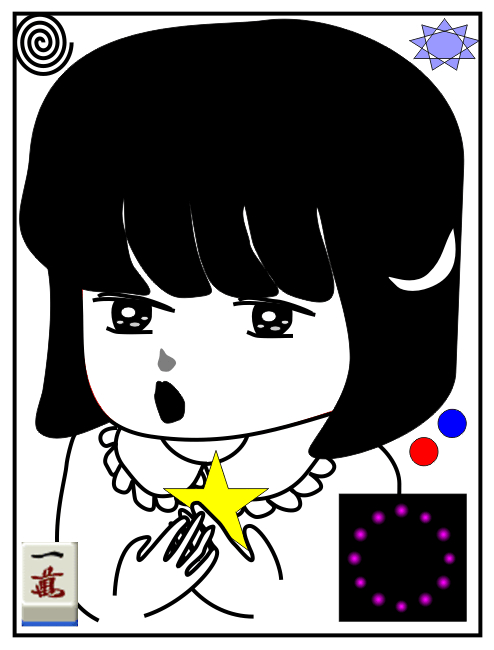
変化の見落としは錯視扱いされる傾向にある。 なぜ?
Change blindness tends to be regarded as something like illusion. Why?
"Change blindness is the striking failure to see large changes that normally would be noticed easily" (Simons and Rensink, 2005)
変化の見落としには気づいて当然、という知識(先入観)がある。
変化の見落としが使われているカードマジック「三人のクイーン」の実演
松田道弘 (2001) 「あそびの冒険 全5巻 4 ミラクル・トランプ・マジック」 ブッキング pp. 33-34
ところで
「不変化の見落とし」は錯視か?
Is "no-change blindness" an illusion?

「変わらないのはどこ?」
Only one image does not change. Which is it?
2枚の画像が切り替わるたびに、8つのうち1つだけ変化しない。それはどこ?
Copyright Akiyoshi .Kitaoka 2007 (May 26)
ブランクなしならすぐわかる。
No change is readily detected without blank.

「不変化の見落とし」は錯視扱いされにくいと思われる。 なぜ?
"No-change blindness" will not be regarded as something like
illusion. Why?
Probably because "no-change blindness" is a failure to realize no-change that observers normally would NOT have any idea about.
気づいて当然、という知識(先入観)がない。
![]() まとめ/Discussion
まとめ/Discussion ![]()
観察者が変化の検出を容易であるはずだと認識している場合、変化の見落としは錯視ということになる(実際の知覚としては容易でないから)。一方、「不変化の見落とし」という刺激条件を観察者はあらかじめ想像しないため、錯視扱いされにくい。
If observers suppose that they should notice the change EASILY, change blindness is an illusion because it is actually difficult to notice (perceive) the change. On the other hand, "no-change blindness" does not tend to be an illusion because observers usually do not imagine the situation.
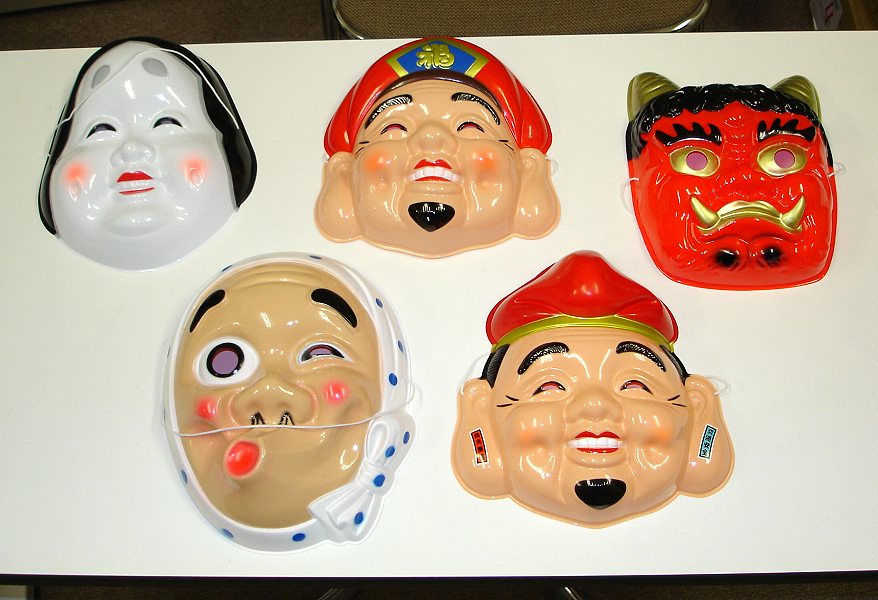
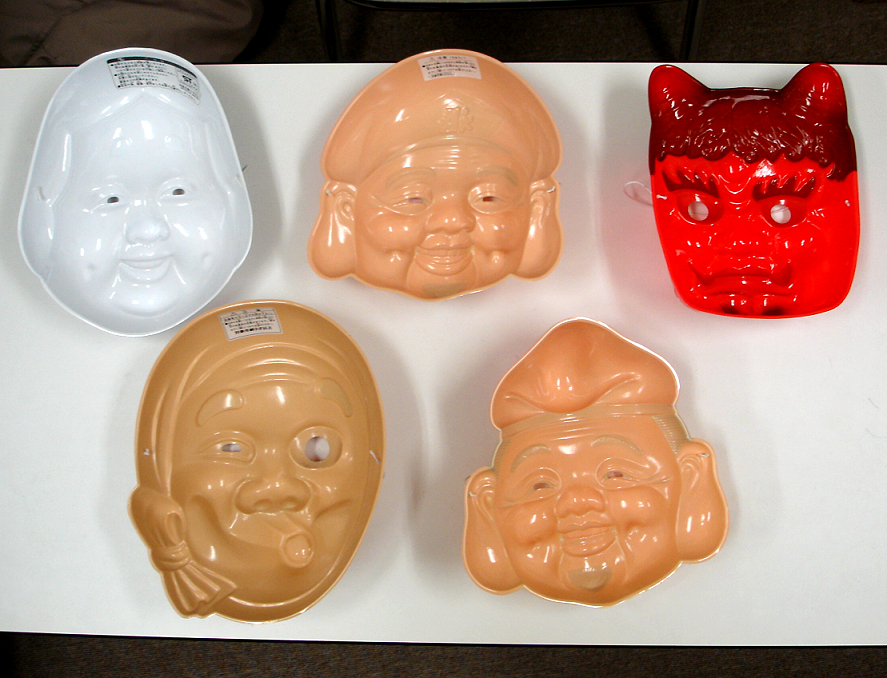
ホロウフェース錯視(凹面顔錯視)
Hollow face illusion
Gregory, R. L. (1970) The
Intelligent Eye. London: Weidenfeld and Nicolson. (グレゴリー著・金子隆芳訳 インテリジェント・アイ みすず書房 1972年刊)
Schröder, H. (1858) Ueber eine optische Inversion bei Betrachtung verkehrter, durch optische Vorrichtung entworfener physischer Bilder. Annalen der Physik und Chemie, 181, 298-311.
不可能図形
Impossible figure
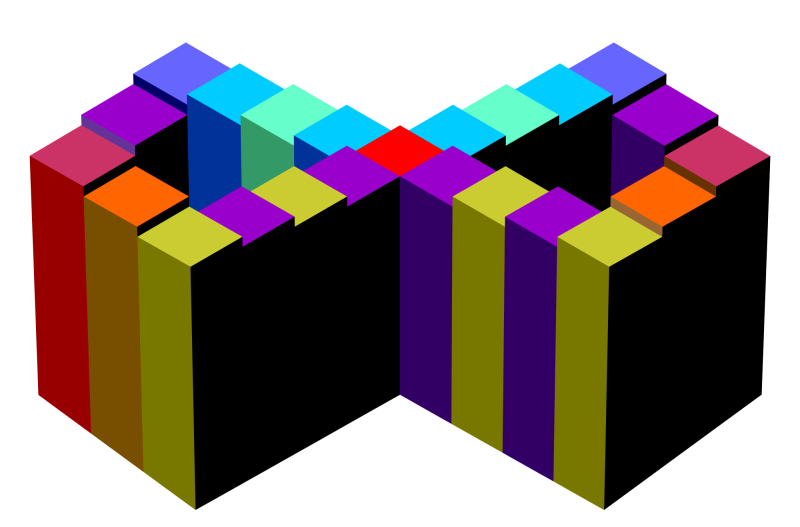
「無限無限階段」
上がり続けるか、下り続けるかの階段に見える。
Copyright Akiyoshi Kitaoka 2009 (March 13)
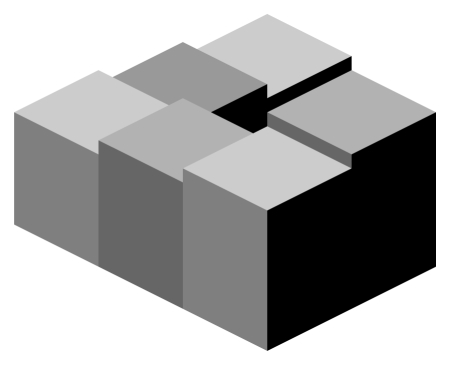
「最少の無限階段」
無限階段の簡略版。
Copyright Akiyoshi Kitaoka 2009 (March 11)
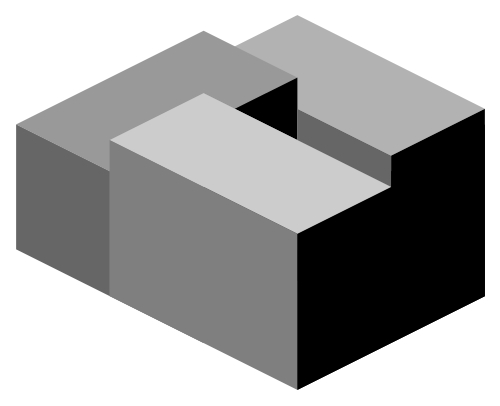
「本当に最少の無限階段」
無限階段の簡略版。階段という感じではなくなるが。
Copyright Akiyoshi Kitaoka 2009 (March 15)

ペンローズの三角形(Penrose's triangle)
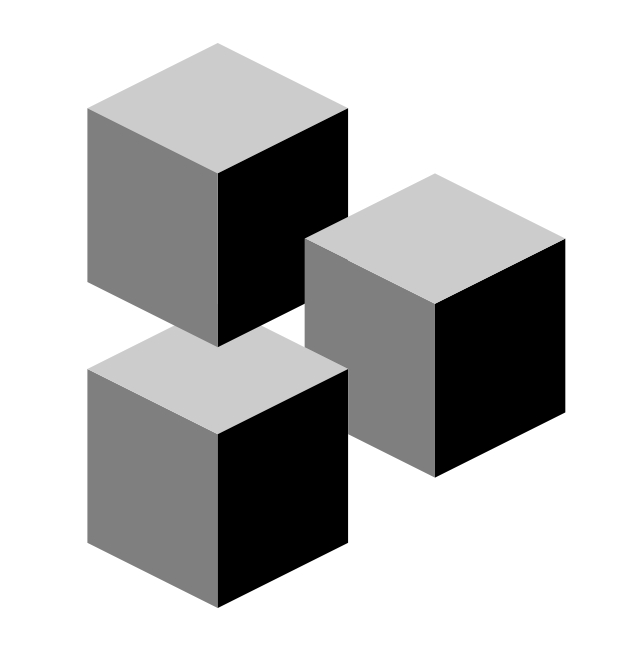
ペンローズの三角形の基本構造
透明視
Perceptual transparency

「透明に見えるビル」
"Transparent" tower
中央のビル(クリスタルタワー)が透明に見える。
Copyright Akiyoshi Kitaoka 2007 (May 1)

「透明に見える山」
"Transparent" mountain
中央の山が透明に見える。
Copyright Midori Takashima 2007
高島翠さんより,
2007/5/1
(東京都町田市内の小山馬場谷戸公園付近から西の方角を望む)
北岡明佳のコメント: Adelson-Anandan-Andersonのモデルで言えば、bistable transparency (両義的透明視あるいは二値安定透明視あるいは反転可能透明視)である。
なお、「透明に見える山」の報告はこれが初めてではなく、池田(1993)(関西大学『社会学部紀要』第25巻第1号pp.165-168)によると、大阪府吹田市の一角から遠望した山に見えるとして、写真が載っている。その池田によると、Metzger (1953) に既に載っている。
透明視については、以下を参照されたい。
透明視講義用のプリント
Kitaoka, A. (2005) A new explanation of perceptual transparency connecting the X-junction contrast-polarity model with the luminance-based arithmetic model. Japanese Psychological Research, 47, 175-187. Reprint or PDF request to me
関連した錯視写真
![]() 例えば、透明視(perceptual transparency)は普段は錯視扱いされないが、上図のように錯視扱いされることもある。それは、錯覚というものが、「実在する対象の特性とは異なる知覚」 であることによる。対象の実在性は実は自明のことではなく、「錯視刺激」を知覚する時に既に用意されている知識あるいはスキーマに依存する。この点が、錯視の認知心理学的性質である。
例えば、透明視(perceptual transparency)は普段は錯視扱いされないが、上図のように錯視扱いされることもある。それは、錯覚というものが、「実在する対象の特性とは異なる知覚」 であることによる。対象の実在性は実は自明のことではなく、「錯視刺激」を知覚する時に既に用意されている知識あるいはスキーマに依存する。この点が、錯視の認知心理学的性質である。
![]() Illusion refers to the misperception that differs from the properties of a real object. Actually, the reality of an object depends on the
knowledge or schema of the observer. This point is one of the important aspects of illusion that require
cognitive psychology.
Illusion refers to the misperception that differs from the properties of a real object. Actually, the reality of an object depends on the
knowledge or schema of the observer. This point is one of the important aspects of illusion that require
cognitive psychology.
色の恒常性
Color constancy
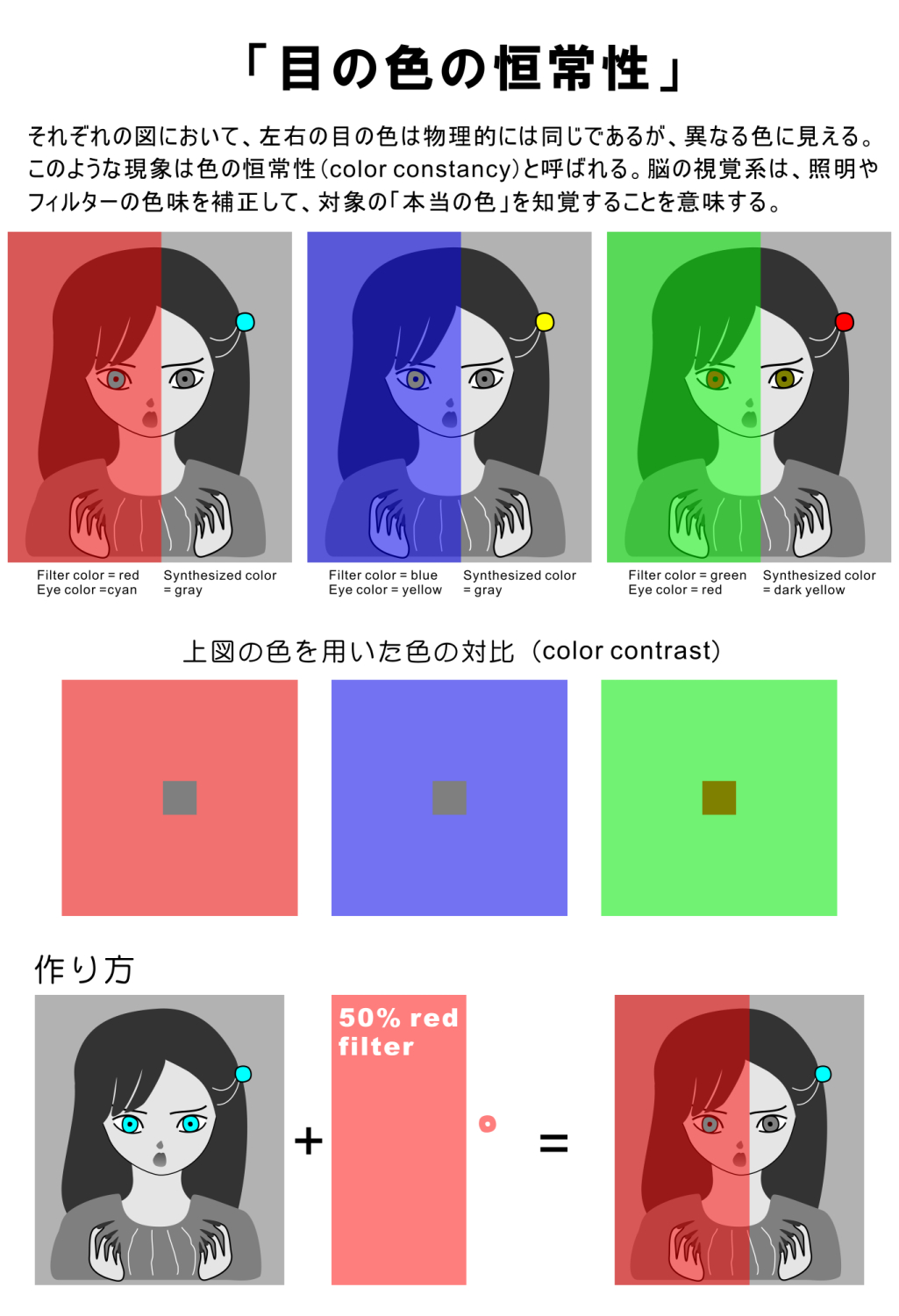
「目の色の恒常性」の簡易プリント
Copyright Akiyoshi .Kitaoka 2009 (July 26)
<配布プリント>
Kitaoka, A. (2010) A brief classification of colour illusions. Colour: Design & Creativity, 5 (3),
1-9.
http://www.colour-journal.org/2010/5/3/

「青い金閣」
金閣の金箔部分は物理的には青みがかった灰色なのであるが、金色に見える。
Copyright Akiyoshi Kitaoka 2009 (May 1)
元の写真

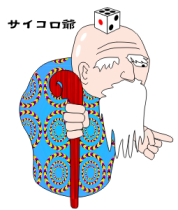 錯視と言えばやっぱり幾何学的錯視
錯視と言えばやっぱり幾何学的錯視
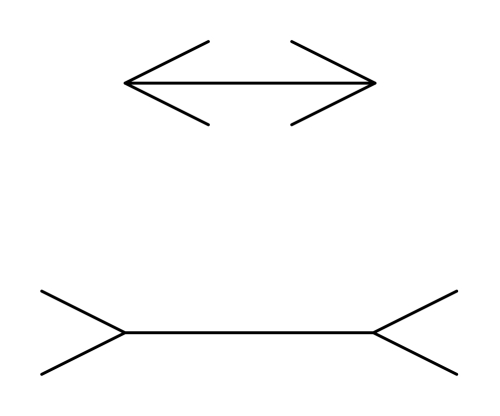
ミュラー=リヤー錯視
Müller-Lyer illusion
横線は上下で同じ長さであるが、下の方が上より長く見える。
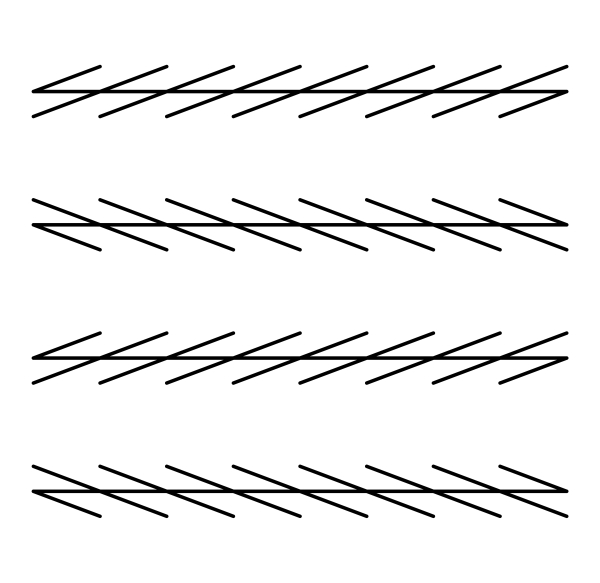
ツェルナー錯視
Zöllner illusion
平行な4本の水平線が、上から右・左・右・左に傾いて見える。
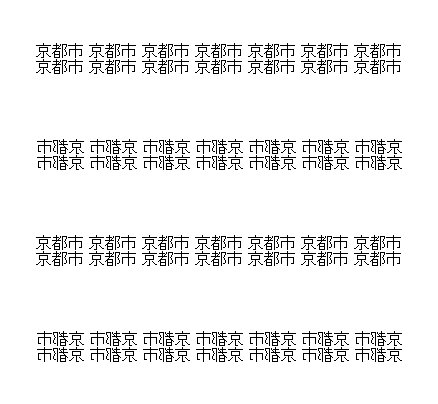
「京都市傾き錯視」
京都市文字列は右に傾いて見える。
Copyright Akiyoshi Kitaoka 2010 (June 25)
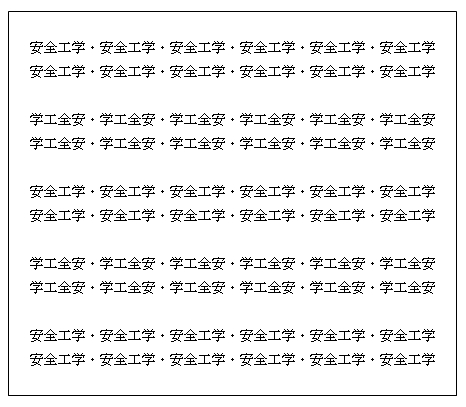
「安全工学傾き錯視」
「安全工学」文字列は右上がりに見える。
Copyright Akiyoshi Kitaoka 2007 (April 15)
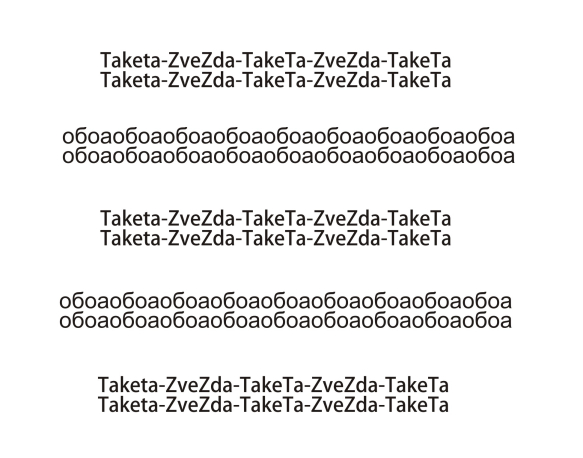
「セルビア語傾き錯視」
1、3、5列目の文字列(ラテン文字)は左に、2、4列目(キリル文字)は右に傾いて見える。世界初のセルビア語による文字列が傾いて見える錯視である。ラテン文字、キリル文字の傾き錯視としても世界初かも。
oбoa = オーボエ, taketa = ケーラーの造語taketeを変えたもの, zvezda = 星
Copyright
Stevanov, J. 2009 (November 24)
from 安美奈(Jasmina), Department
of Psychology, Ritsumeikan University

「膨らみの錯視」
"Bulge"
市松模様の床が膨らんでこちらにせり出しているように見えるが、物理的にはすべて正方形で描かれており、感じられる丸みは錯視である。
The image consists of squares.
Copyright A.Kitaoka 1998
![]() 市松模様錯視(checkered illusion)
市松模様錯視(checkered illusion)
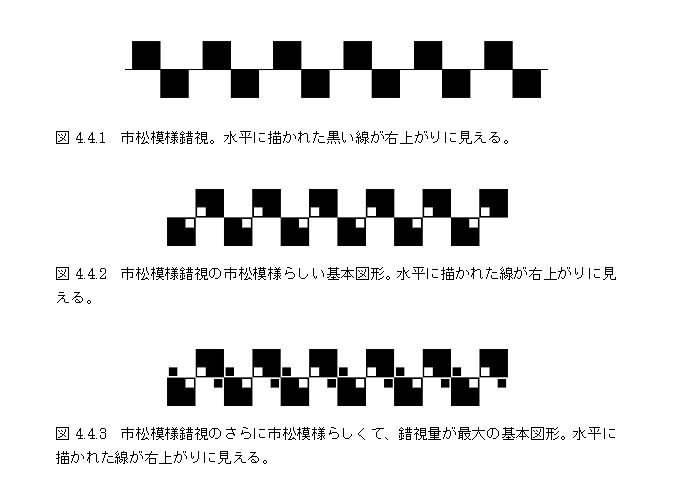
![]() ずれた線の錯視(illusion of shifted lines)
ずれた線の錯視(illusion of shifted lines)
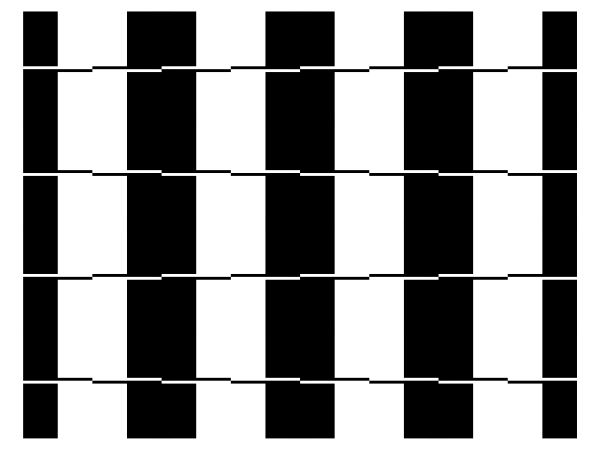
Kitaoka, A. (1998). Apparent contraction of edge
angles. Perception, 27, 1209-1219. ![]() Scanned
PDF request to me
Scanned
PDF request to me
Kitaoka, A., Pinna, B., and Brelstaff, G.
(2004). Contrast polarities determine the direction of Café Wall tilts.
Perception, 33, 11-20. ![]() PDF
request to me.
PDF
request to me.
Kitaoka, A. (2007) Tilt illusions after Oyama
(1960): A review. Japanese Psychological Research, 49, 7-19. ![]() PDF
request to me
PDF
request to me
The limiting case of
the Fraser illusion family
In each square, the middle line or
edge appears to tilt counterclockwise.
左に傾いて見える錯視を作り出す最小単位。
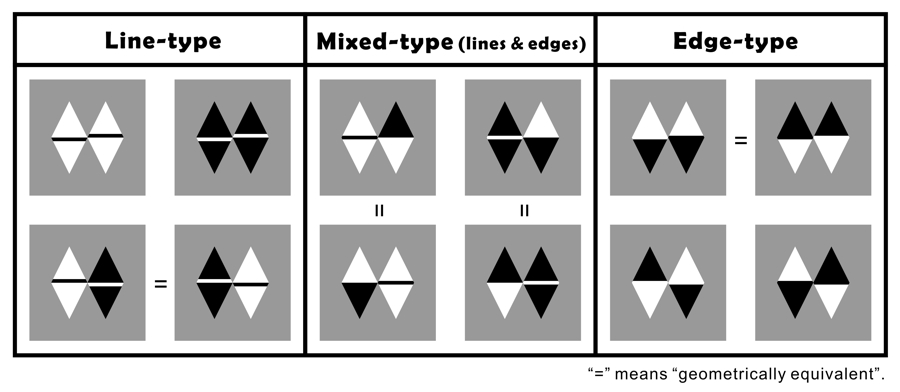
Line-type と Edge-type の上列が phi に相当し、下列が reversed phi に相当する。
Copyright Akiyoshi Kitaoka 2010 (March 22)
北岡明佳 (2010) 「フレーザー錯視は2種類あった!」 (第43回知覚コロキウム・2010年3月25日(木)~27日(土)・発表日は27日、弥彦グランドホテル) 発表に使用したウェブページ
Motion illusion by visual delay
脳内処理時間がわかる錯視
「踊るハート達」
ハートが動いて見える。めがねをかけている人は、めがねを動かすとよく見えるかもしれない。離れたところから見ると、明るくなった時のハートは白のランダムドットより手前に見え、暗くなった時のハートは奥に見える人が過半数と予想される。
Copyright Akiyoshi Kitaoka 2006 (December 20)
<配布プリント>
モノクロでOK

配布物
「踊るハート達」 (MS-Word ファイル)
北岡明佳 (2006) 色が強くなる錯視 A・F・Tジャーナル, 31 (Summer), pp. 01.
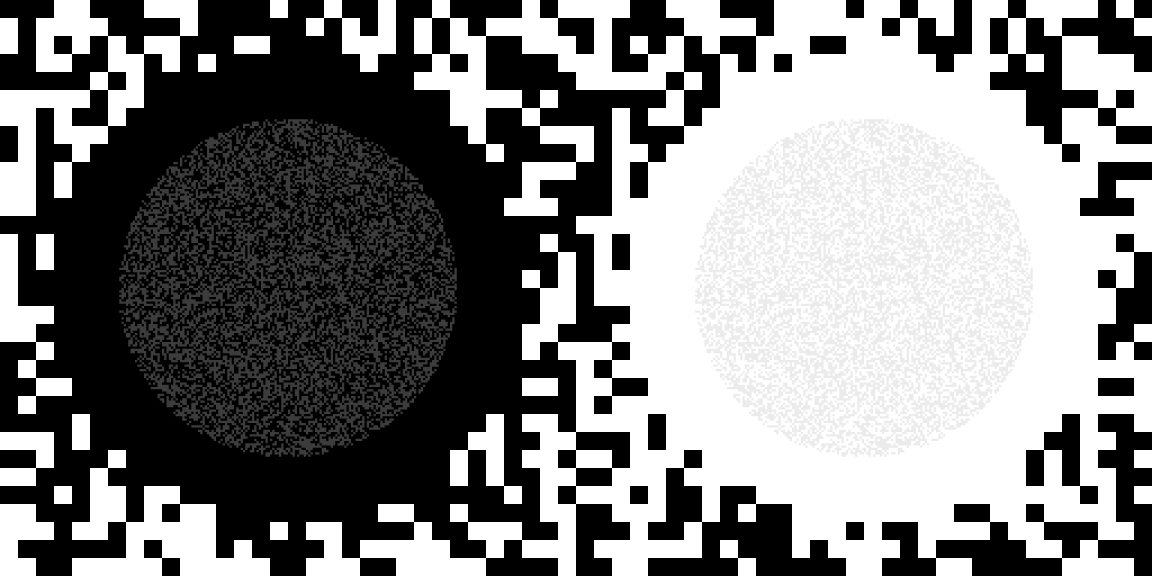
低輝度→脳内処理時間が長い
cf. プルフリッヒ効果
低輝度コントラスト→脳内処理時間が長い <our finding!>
1. High-luminance parts show shorter latency than low-luminance part.
2. High-contrast parts show shorter latency than low-contrast part. <our finding!>
Kitaoka, A. and Ashida, H. (2007) A variant of the anomalous motion illusion based upon contrast and visual latency. Perception, 36, 1019-1035. PDF
cf.
踊るハート(fluttering-heart illusion)

(Helmholtz, 1867; Nguyen-Tri and Faubert 2003; von Grünau 1975a, 1975b, 1976; von Kries 1896)
中山(2008)によると、踊るハートは赤が重要。青不要。ピンクはダメ。
中山明子 (2008) 「踊るハート」錯視(1844)と「踊るハート達」錯視(2006)の比較検証 2008年度立命館大学文学部(人文学科心理学専攻)卒業論文
色が変わる錯視の作品「2つの環」
color changing illusion "Two rings"
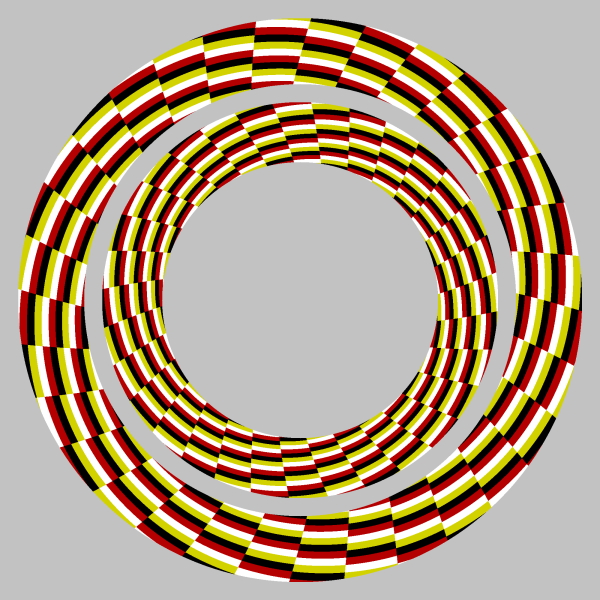
内側のリングは縮小して見え、外側のリングは拡大して見える(最適型フレーザー・ウィルコックス錯視)。中心を見ながら図に目を近づけたり遠ざけたりすると、リングがお互いに反対方向に回転して見える(回転オオウチ錯視)。また、中心を見ながら図に目を近づけると内側のリングが赤味を増し、目を遠ざけると外側のリングが赤味を増す。1つの図で3つも錯視が楽しめるおトクな錯視デザイン。
Copyright A.Kitaoka 2005 (April 1)
<配布プリント>
北岡明佳 (2006) 色が強くなる錯視 A・F・Tジャーナル, 31 (Summer), pp. 01.
Kitaoka, A. (2010) A brief classification of colour illusions. Colour: Design & Creativity, 5 (3), 1-9. new!
http://www.colour-journal.org/2010/5/3/
色が変わる錯視を説明する仮説・・・処理速度説↓
Latency model of the color changing illusion
supposing that red is perceived faster than blue
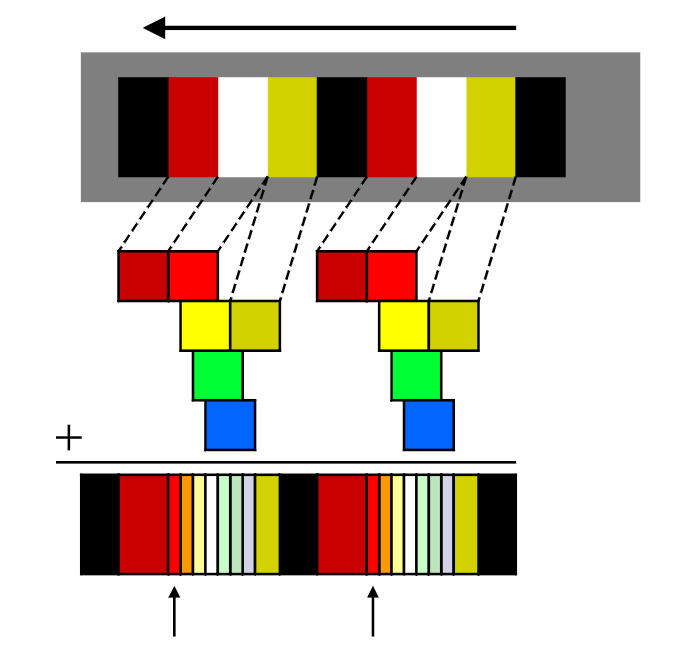
刺激イメージが網膜上で動いた場合、長波長の刺激の視覚処理が早く、短波長の刺激の視覚処理が遅いと考えると説明できる。図では矢印の先の赤が増加して見え、後方に残る青は黄色と打ち消しあって無彩色に近くなる。
「最適化型」フレーザー・ウィルコックス錯視
Optimized Fraser-Wilcox illusion
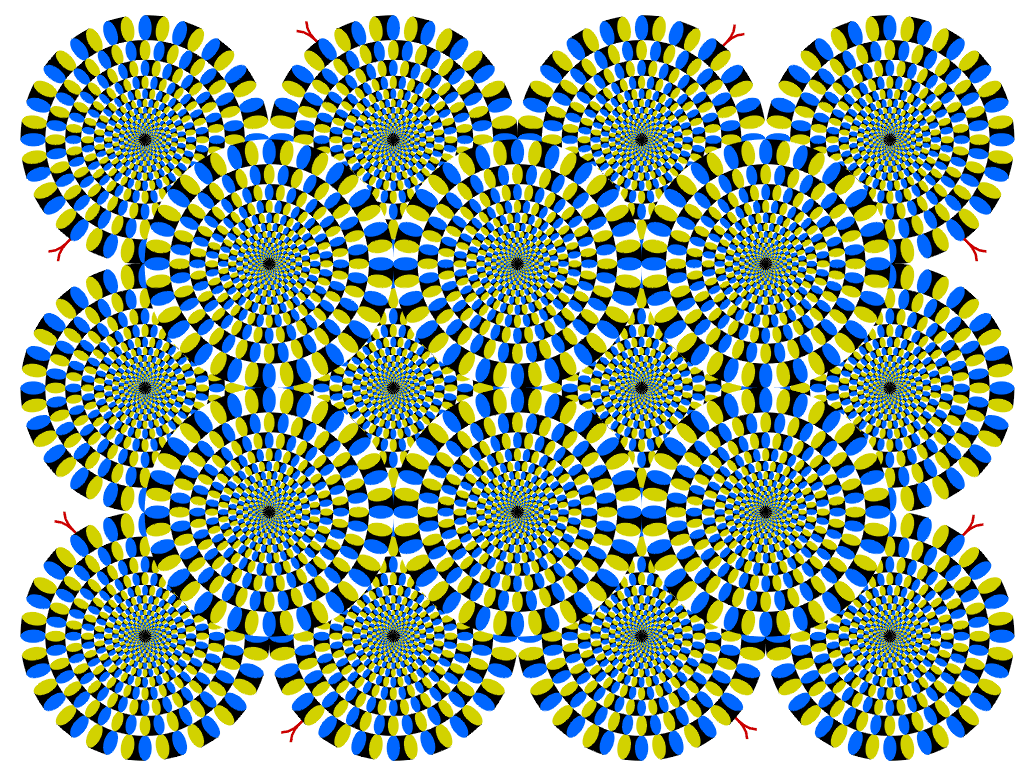
「蛇の回転」
蛇の円盤が勝手に回転して見える。
Copyright A.Kitaoka 2003 (September 2, 2003)
<配布プリント>
黒→濃い灰色→白→薄い灰色→黒 の方向に動いて見える錯視である。
Direction: black → dark-gray → white → light-gray → black
「最適化型」フレーザー・ウィルコックス錯視・タイプ I
Optimized Fraser-Wilcox illusion, Type I
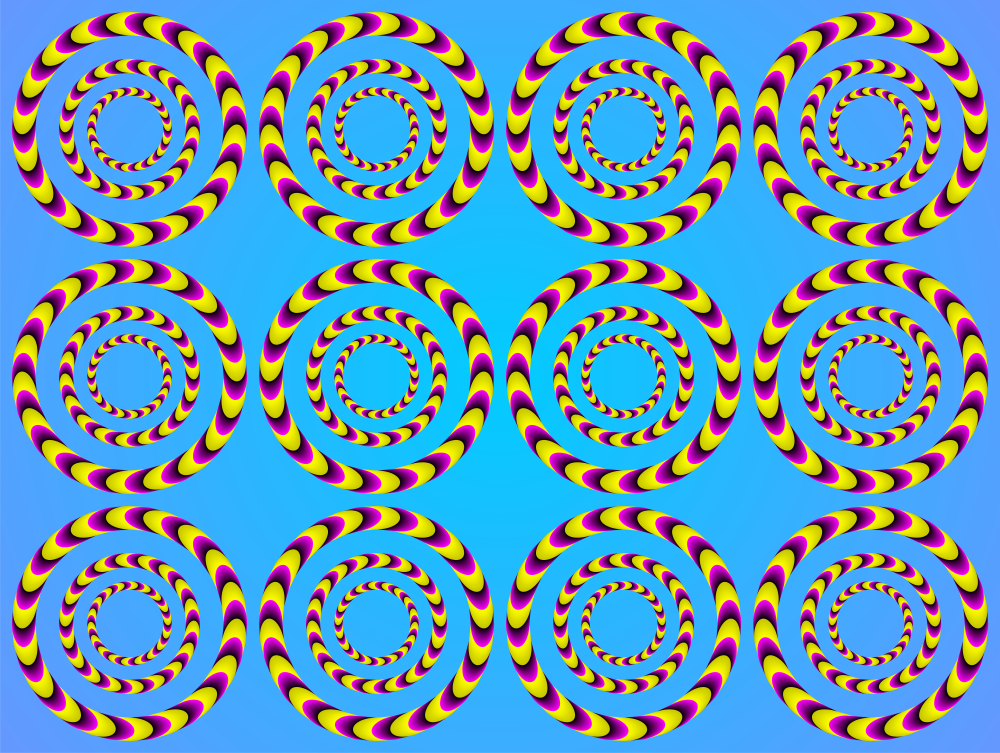
「赤い蛇の回転の詰め合わせ」
リングがゆっくり、あるいは急速に回転して見える。
Copyright Akiyoshi Kitaoka 2008 (March 19)
「最適化型」フレーザー・ウィルコックス錯視・タイプ IIa
Optimized Fraser-Wilcox illusion, Type IIa
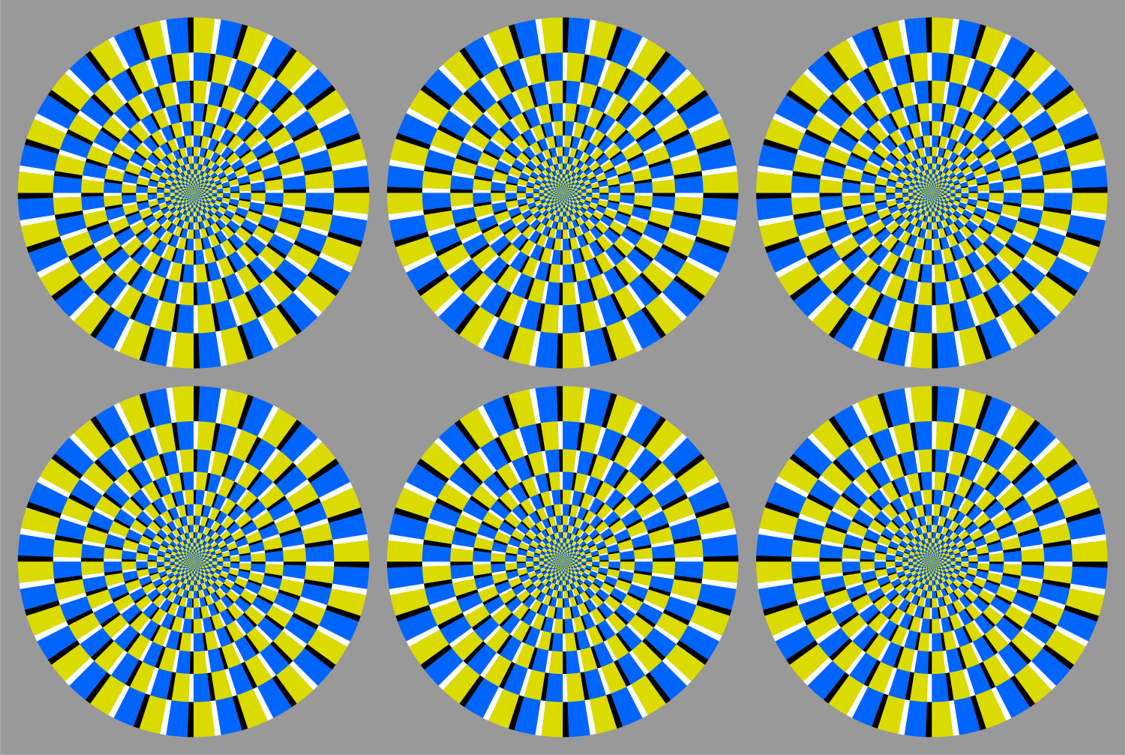
「最適化型」フレーザー・ウィルコックス錯視・タイプ III
Optimized Fraser-Wilcox illusion, Type III
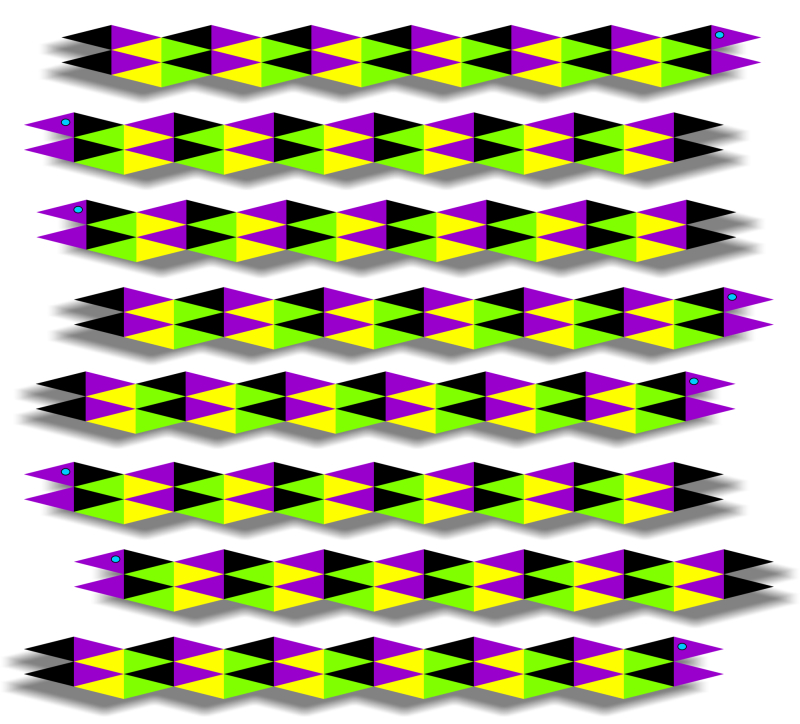
「影付きの左右に動く蛇」
蛇が左右に動いて見える。
Copyright Akiyoshi Kitaoka 2009 (June 7)
「最適化型」フレーザー・ウィルコックス錯視・タイプ IV
Optimized Fraser-Wilcox illusion, Type III
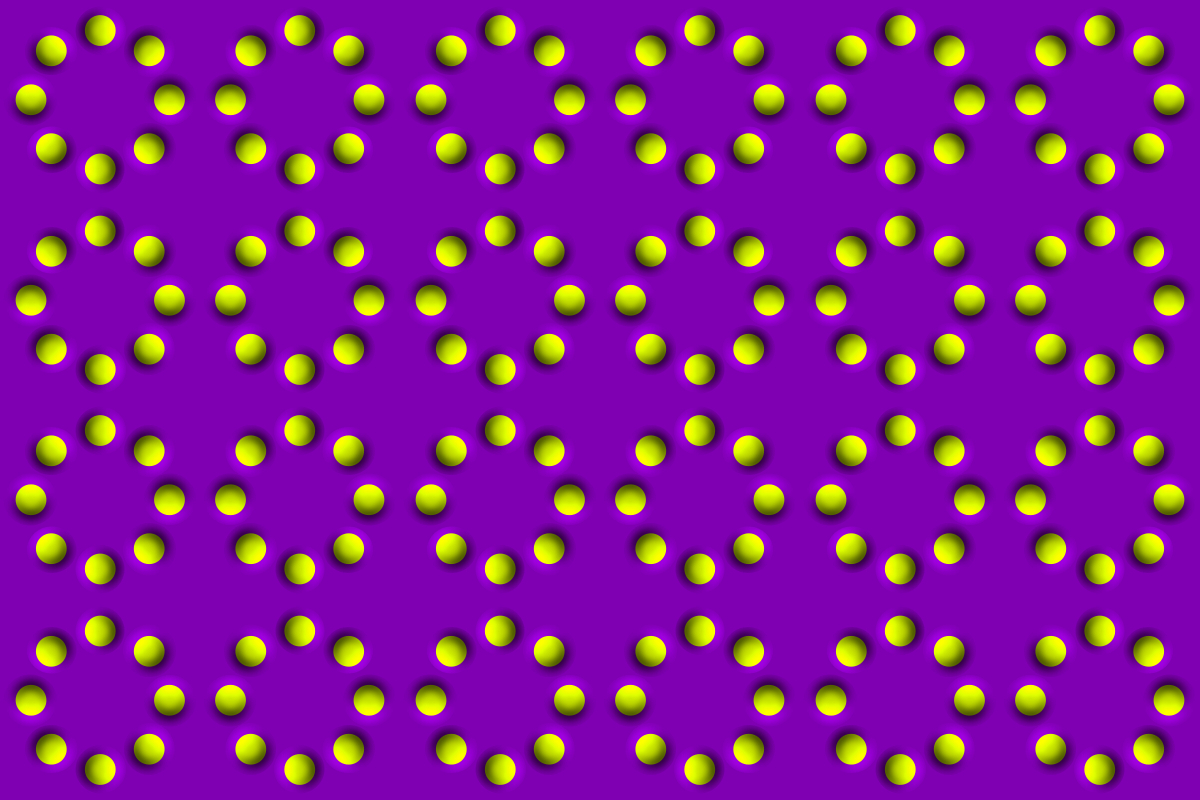
「錠剤の回転」
(たくさん版)
錠剤のリングが回転して見える。
Copyright Akiyoshi Kitaoka 2009 (March 24)
赤と紫特有の「最適化型」フレーザー・ウィルコックス錯視・タイプ V
Optimized Fraser-Wilcox illusion, Type V
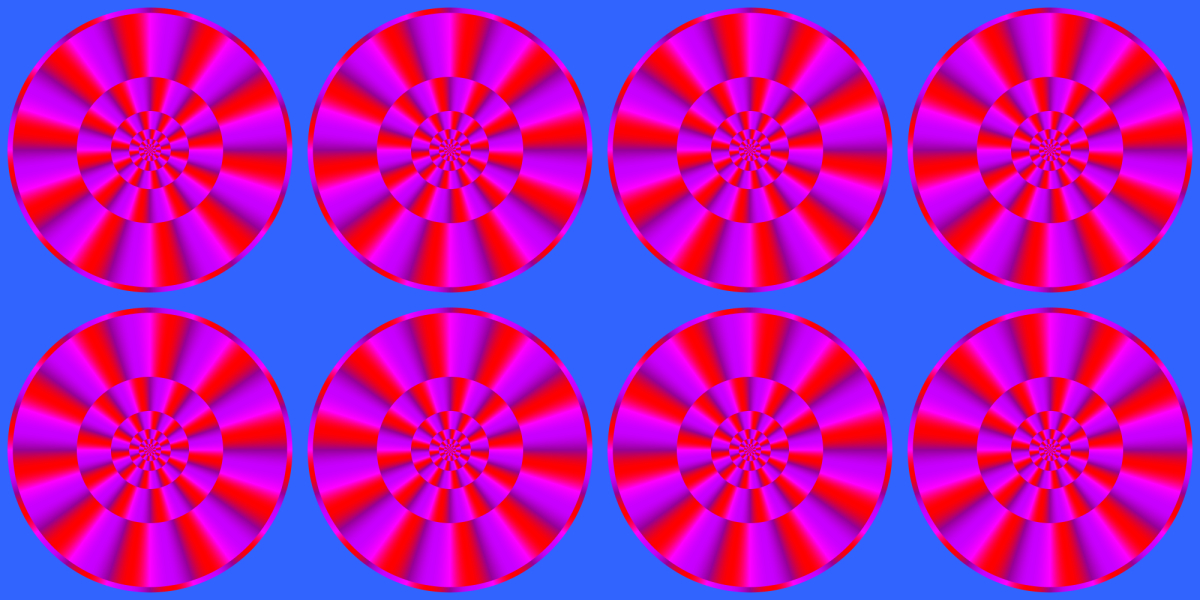
「赤い円盤の回転」
赤い円盤が回転して見える。
Copyright Akiyoshi Kitaoka 2008 (December 18)
最適化型フレーザー・ウイルコックス錯視群
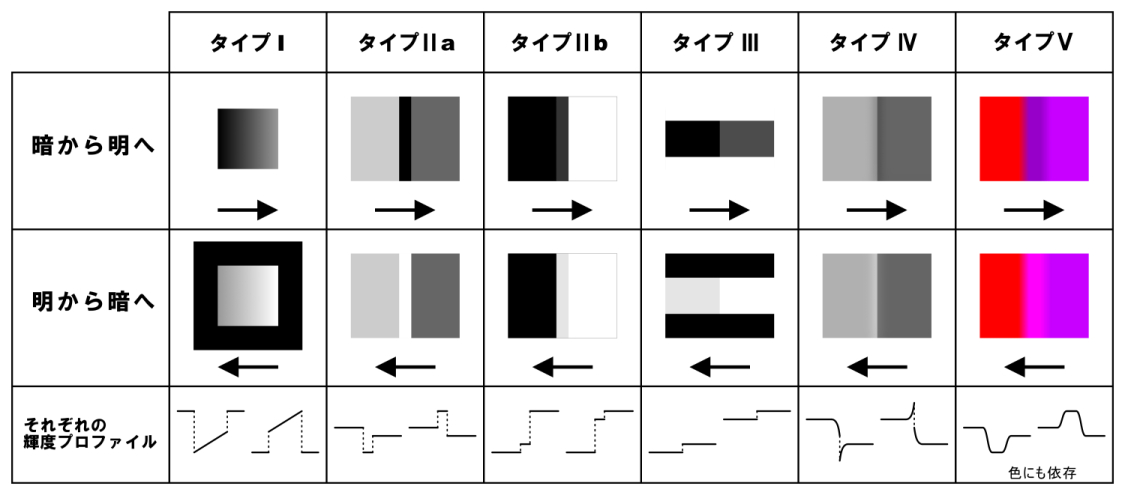
Kitaoka, A. (2007) Phenomenal classification
of the “optimized” Fraser-Wilcox illusion and the effect of color. Poster
presentation in DemoNight, VSS2007, GWiz, Sarasota, Florida, USA, May 14,
2007.
Kitaoka, A. (2008) Optimized Fraser-Wilcox illusions: A pictorial classification by Akiyoshi Kitaoka. Talk in a workshop (WS005) in the 72nd Annual Convention of the Japanese Psychological Association, Hokkaido University, Sapporo, September 19, 2008. Presentation page
この錯視のわかりやすい説明のある本
北岡明佳著 人はなぜ錯視にだまされるのか? トリック・アイズ メカニズム カンゼン刊
(定価:1,600円(税別) ISBN 978-4-86255-020-0) アマゾンのページ
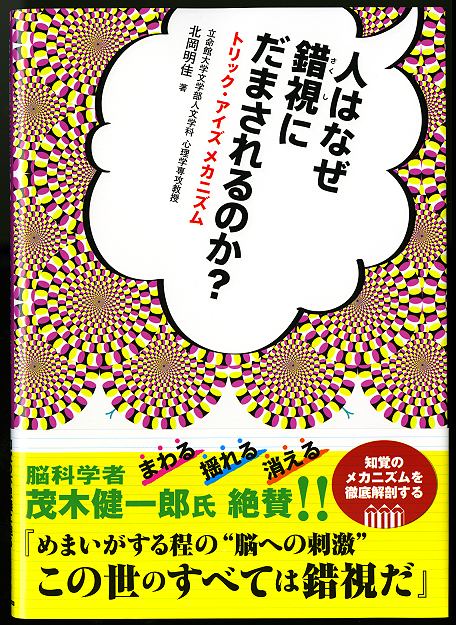
錯視のメカニズムの解説多し!
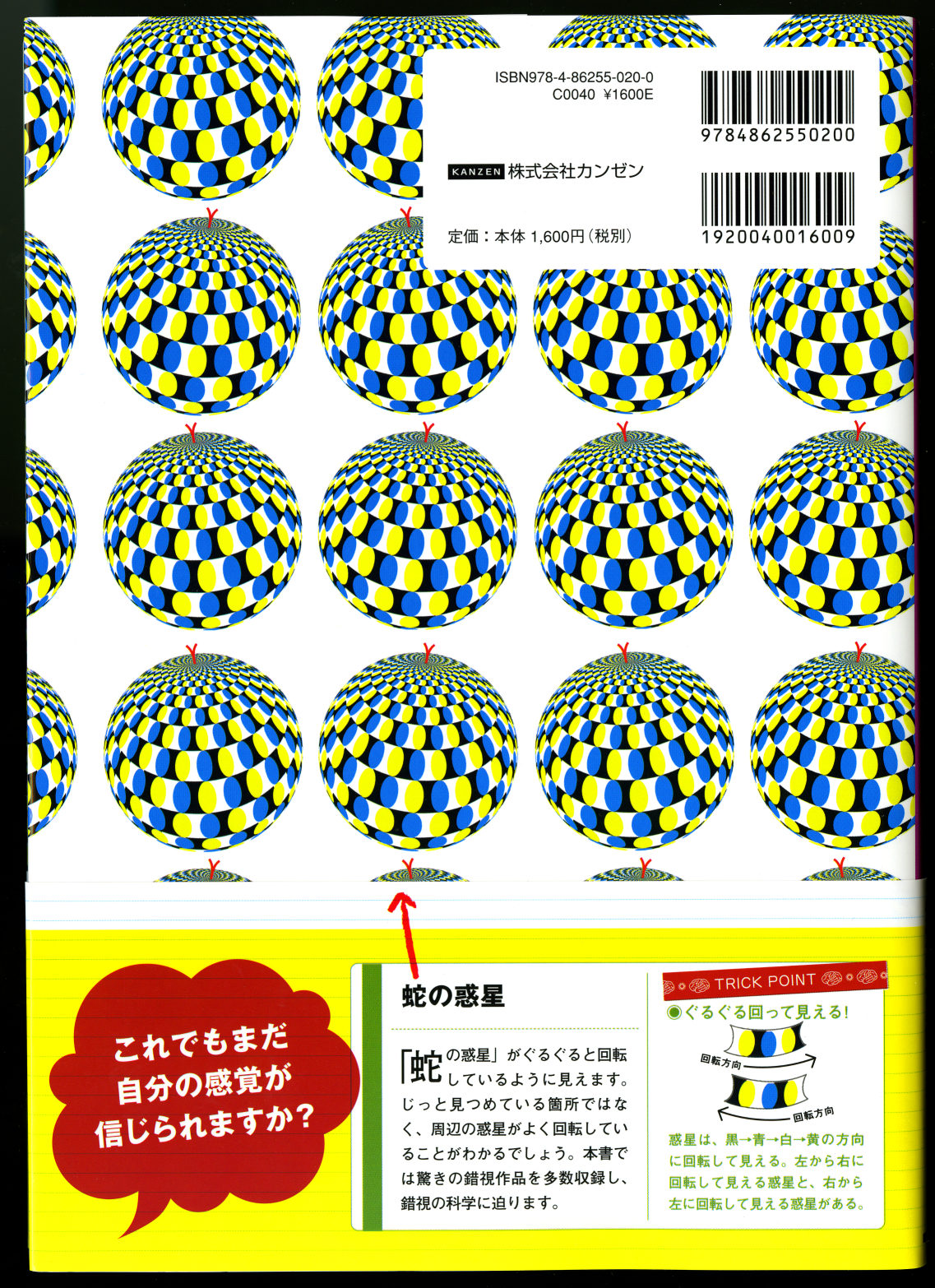
1. Fraser and Wilcox (1979)
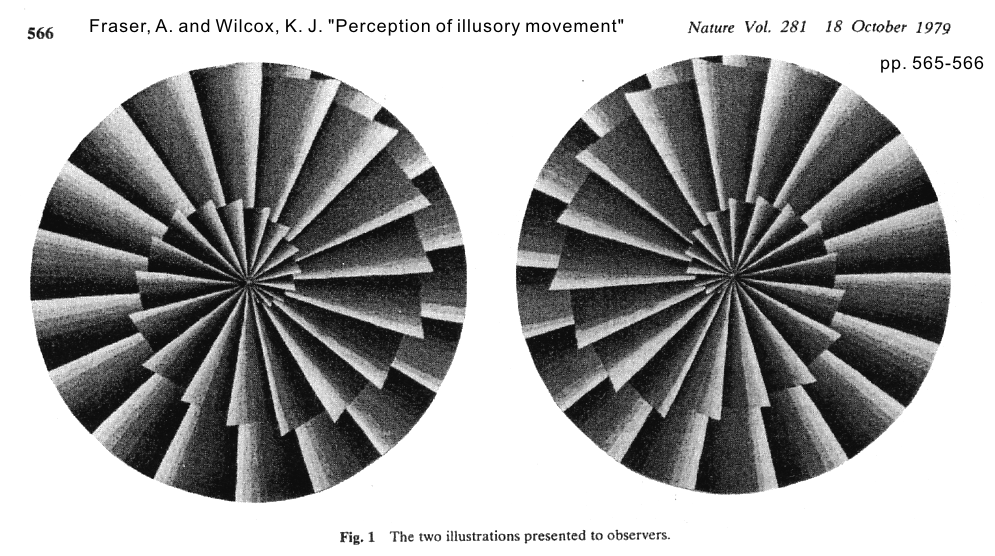
Fraser, A. and Wilcox, K. J. (1979) Perception of illusory movement. Nature, 281, 565-566.
2. Faubert and Herbert (1999)
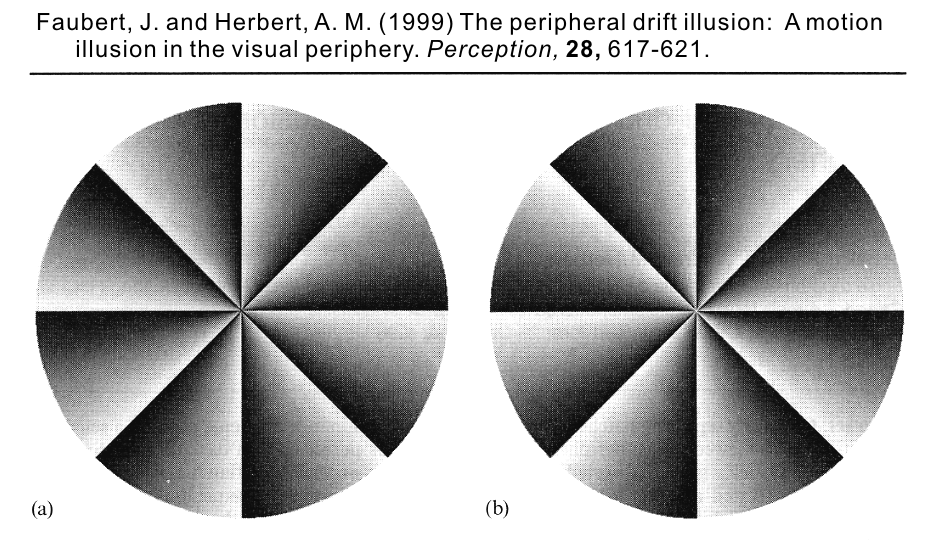
Faubert, J. and Herbert, A. M. (1999) The peripheral drift illusion: A motion illusion in the visual periphery. Perception, 28, 617-621.
3. Naor-Raz and Sekuler (2000)
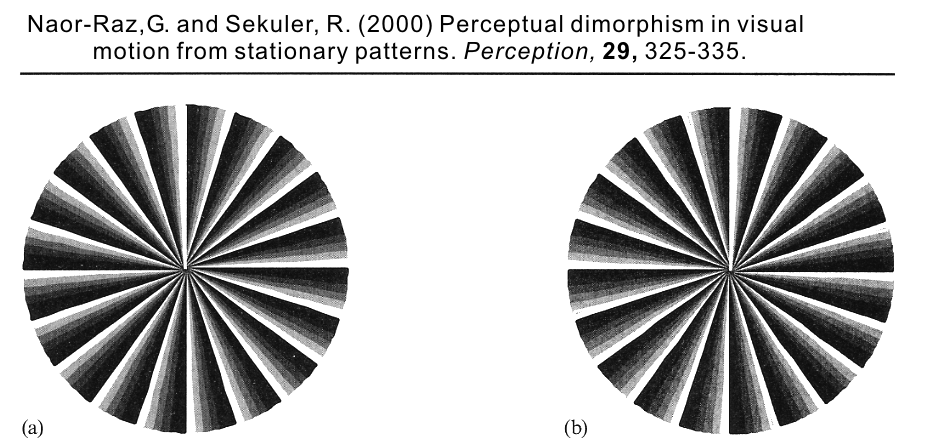
Naor-Raz, G. and Sekuler, R. (2000) Perceptual dimorphism in visual motion from stationary patterns. Perception, 29, 325-335.
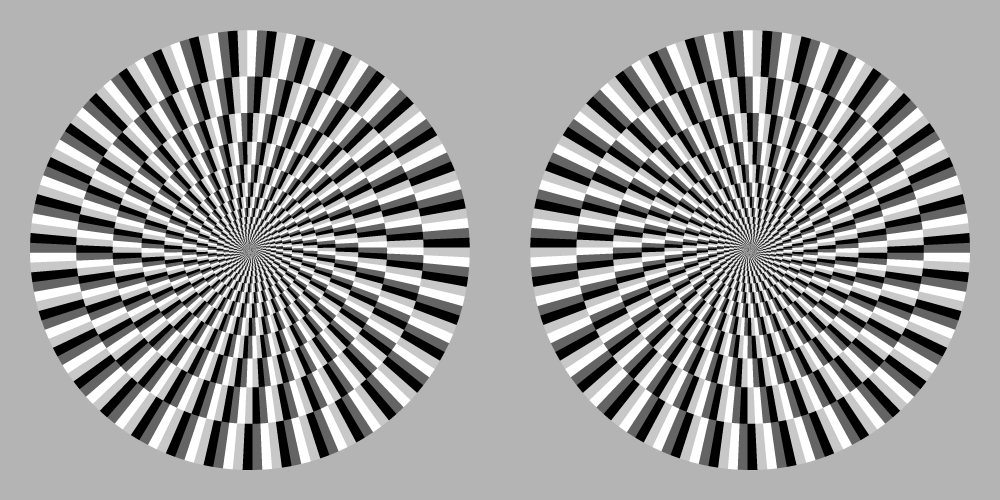
Kitaoka, A. and Ashida, H. (2003) Phenomenal characteristics of the peripheral drift illusion. VISION (Journal of the Vision Society of Japan), 15, 261-262
![]() Related references
Related references ![]()
Tomimatsu, E., Ito, H., Seno, T., and Sunaga, S. (2010) The ‘rotating snakes’ in smooth motion do not appear to rotate. Perception, 39, 721-724.
Fermüller, C., Ji, H., and Kitaoka, A. (2010) Illusory motion due
to causal time filtering. Vision Research, 50,
315–329. ![]()
Kuriki, I., Ashida, H., Murakami, I., and Kitaoka,
A. (2008) Functional brain imaging of the Rotating Snakes illusion by fMRI.
Journal of Vision, 8(10):16, 1-10. ![]()
Hisakata, R. and Murakami, I. (2008) The effects of eccentricity and retinal illuminance on the illusory motion seen in a stationary luminance gradient. Vision Research, 49, 1940-1948.
Beer, A. L., Heckel, A. H. and Greenlee, M. W. (2008) A motion illusion reveals mechanisms of perceptual stabilization. PLoS ONE, 3(7): e2741, 1-7. doi:10.1371/journal.pone.0002741 Freely available online
Chi, M-T., Lee, T-Y., Qu, Y., and Wong, T-T. (2008) Self-Animating Images: Illusory Motion Using Repeated Asymmetric Patterns. ACM Transaction on Graphics (Proceedings of SIGGRAPH 2008), 27, No.3. SIGGRAPH2008 --- Authors' page --- ![]()
Scientific American Reports Special Edition on Perception (2008). ![]()
Kitaoka, A. and Ashida, H. (2007) A variant of the anomalous motion illusion
based upon contrast and visual latency. Perception, 36, 1019-1035. ![]() PDF request to Akiyoshi Kitaoka
PDF request to Akiyoshi Kitaoka ![]()
Newton Press (Ed.), A. Kitaoka (Supervisor)
(2007) Newton magazine book: Special
issue "How is the brain deceived? Perfect demonstration of visual
illusions" Tokyo: Newton Press (in Japanese; published in October 2007). ![]()
Ramachandran, V. S. and Rogers-Ramachandran, D. (2007) A Moving Experience: How the eyes can see movement where it does not exist. Scientific American Mind, February/March, 14-16.
Kitaoka, A. (2007) Phenomenal classification of the “optimized” Fraser-Wilcox
illusion and the effect of color. Poster presentation in DemoNight, VSS2007,
GWiz, Sarasota, Florida, USA, May 14, 2007. 
Murakami, I., Kitaoka, A. and Ashida, H. (2006)
A positive correlation between fixation instability and the strength of illusory
motion in a static display. Vision Research, 46, 2421-2431. ![]() PDF request
should be sent to Dr. Murakami
PDF request
should be sent to Dr. Murakami ![]()
Kitaoka, A. (2006) Anomalous motion illusion and stereopsis. Journal of Three Dimensional Images (Japan), 20, 9-14. PDF (manuscript but the same as the printed one)
Kanazawa, S., Kitaoka, A. and Yamaguchi, M. K. (2006) Infants see the “Rotating Snake” illusion. Dorsal and ventral streams in the visual system (Talk): Monday, 21 August 2006; 12:00-12:30 (29th European Conference on Visual Perception, St-Petersburg, Russia, 20th-25th August, 2006) Abstract
Kitaoka, A., Ashida, H., and Murakami, I. (2005) Does the peripheral drift illusion generate illusory motion in depth? Journal of Three Dimensional Images (Tokyo), 19, 6-8. PDF (scanned copy) (poor quality) --- MS-Word file (manuscript, the same as the paper) (high quality)
Conway, R. B., Kitaoka, A., Yazdanbakhsh, A., Pack, C. C., and Livingstone,
M. S. (2005) Neural basis for a powerful static motion illusion. Journal of Neuroscience, 25, 5651-5656. ![]() PDF request should be sent to Dr. Conway
PDF request should be sent to Dr. Conway ![]()
Backus, B. T. and Oruç, I. (2005) Illusory motion from change over time in the response to contrast and luminance. Journal of Vision, 5, 1055-1069. http://journalofvision.org/5/11/10/
Kitaoka, A. and Ashida, H. (2003) Phenomenal characteristics of the peripheral drift illusion. VISION, 15, 261-262.PDF
Major models of the "Rotating snakes" illusion (optimized Fraser-Wilcox illusion)
1. Adaptation
Backus, B. T. and Oruç, I. (2005) Illusory motion from change over time in the response to contrast and luminance. Journal of Vision, 5, 1055-1069.
2. Visual delay
Conway, R. B., Kitaoka, A., Yazdanbakhsh, A., Pack, C. C., and Livingstone, M. S. (2005) Neural basis for a powerful static motion illusion. Journal of Neuroscience, 25, 5651-5656.
3. Motion signal asymmetry
Murakami, I., Kitaoka, A. and Ashida, H. (2006) A positive correlation between fixation instability and the strength of illusory motion in a static display. Vision Research, 46, 2421-2431.
I explain the perceptual dimorphism in motion direction as assuming that two independent illusions are involved in the original Fraser-Wilcox illusion.
| Type | Basic illusion that motion direction is from dark to light |
Basic illusion that motion direction is from light to dark |
Examples (click the thumbnail) |
| I | 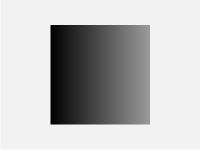 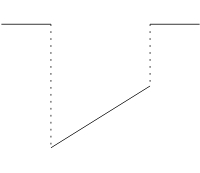 |
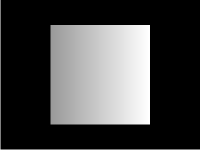 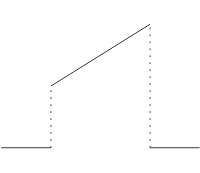 |
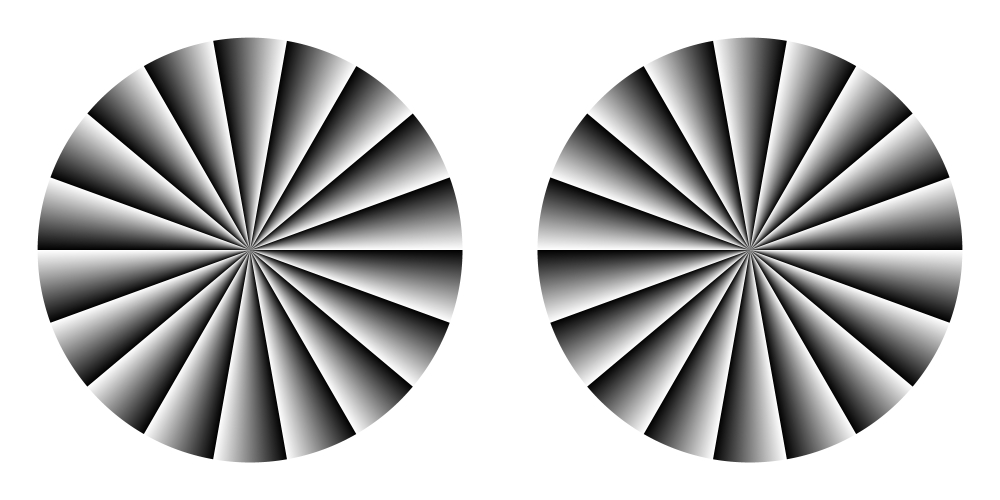
"Dark to light" (in gradation) might be stronger.
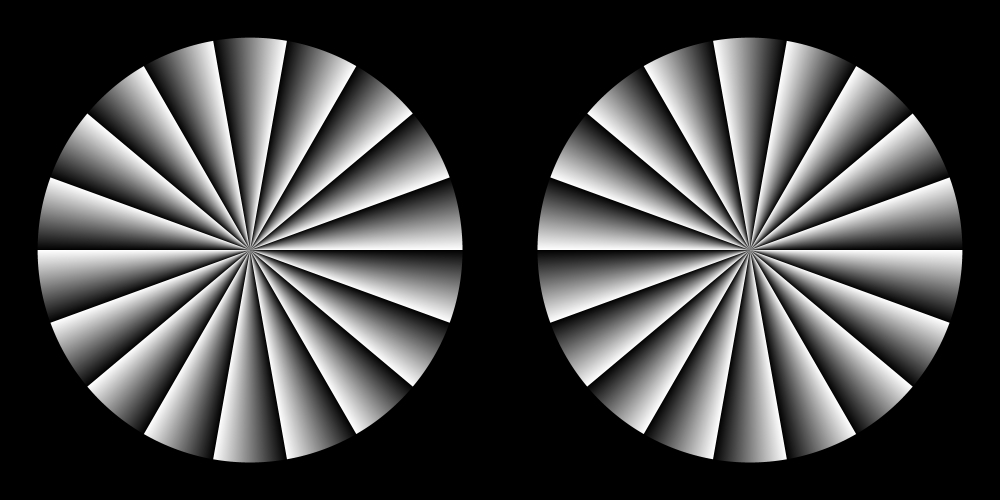
"Light to dark" might be stronger.
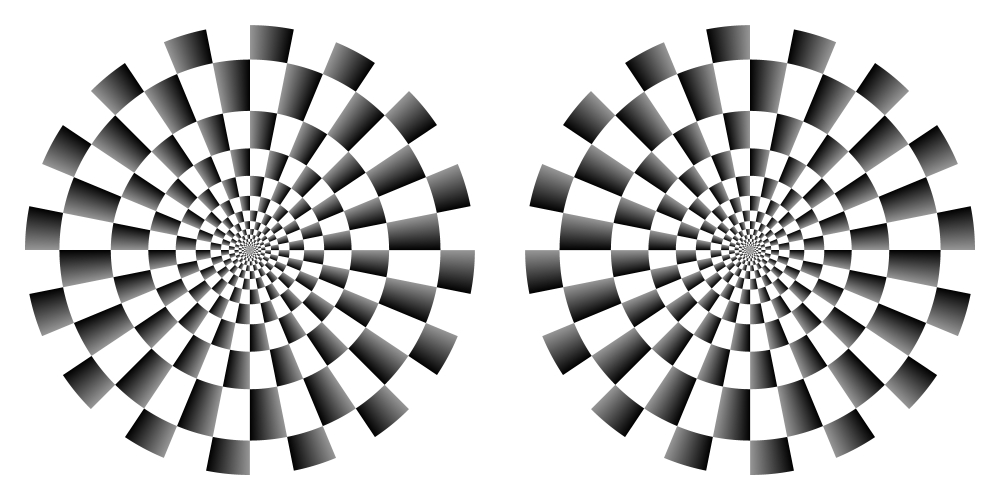
"Dark to light"
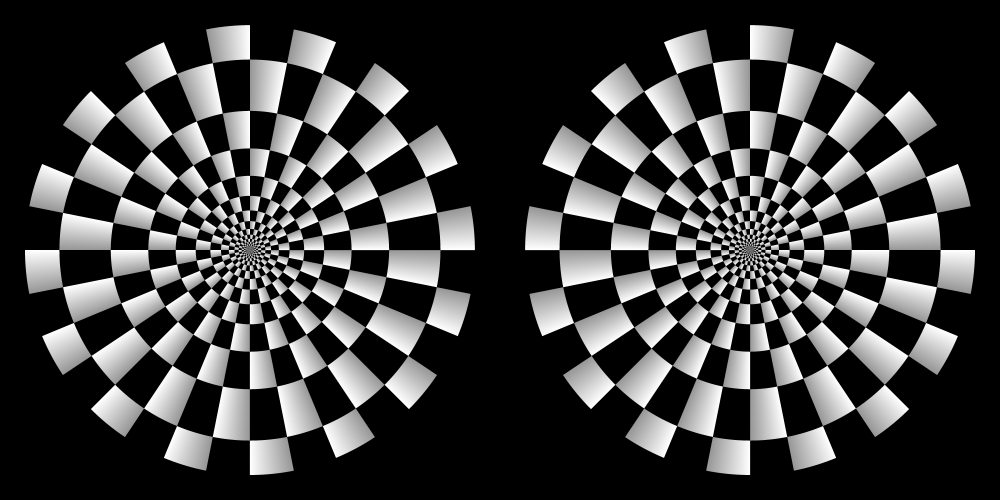
"Light to dark"
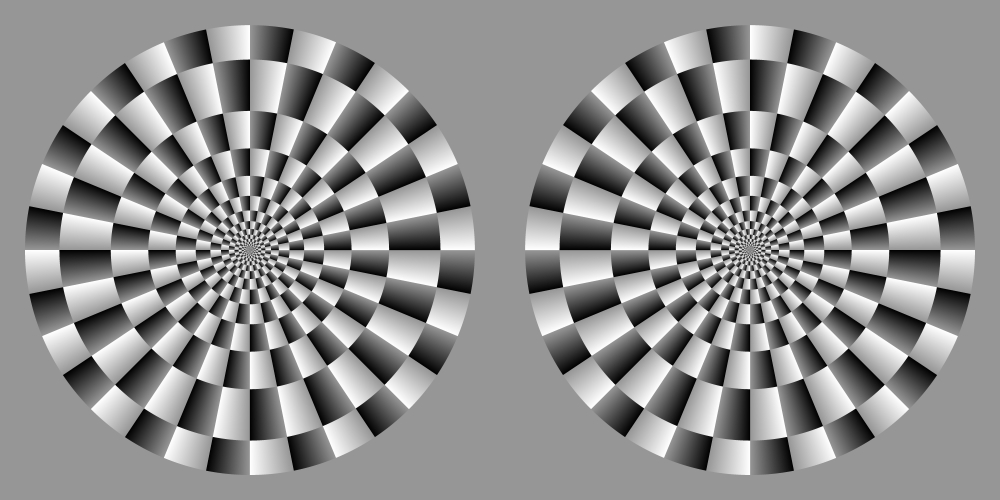
"Dark to light" and "light to dark" in cooperation
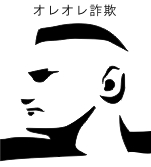 I propose an empirical observation that color might enhance the illusion
in some conditions.
I propose an empirical observation that color might enhance the illusion
in some conditions.
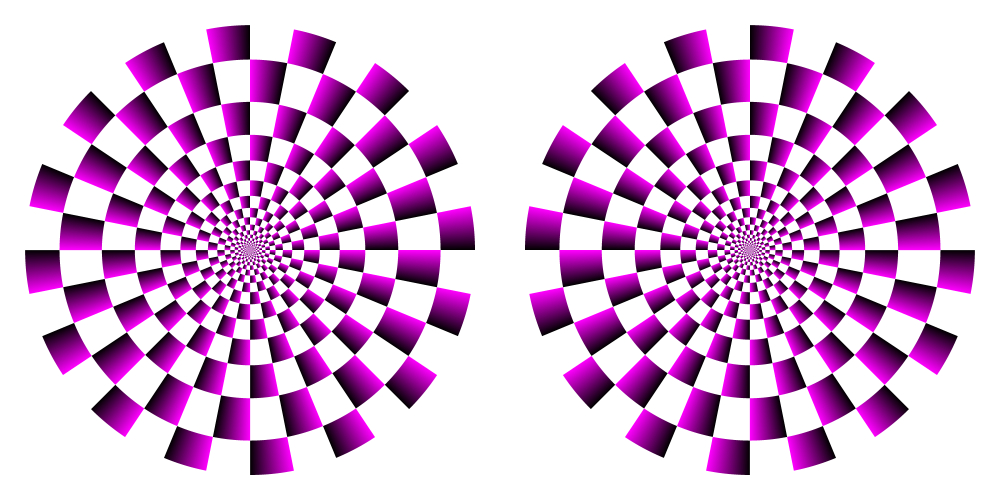
Observation 1. The illusion from dark to light is enhanced by red or blue.
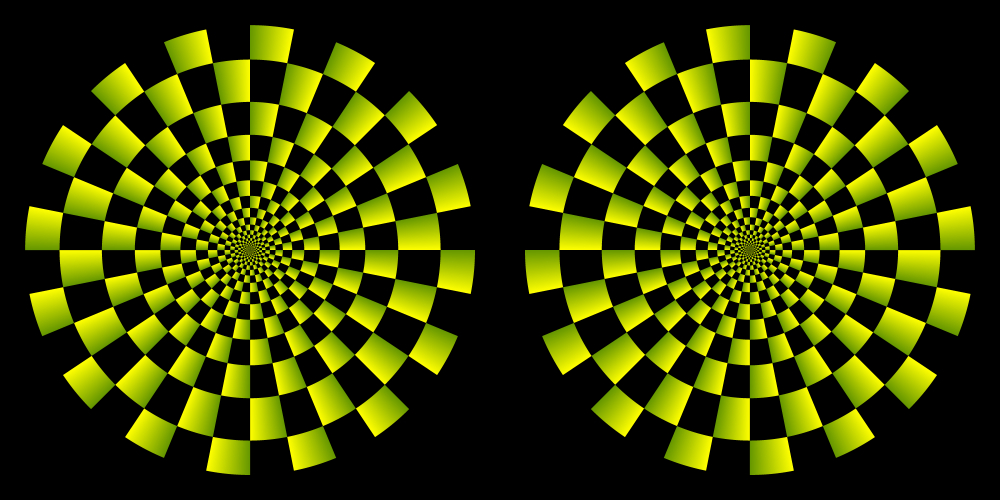
Observation 2. The illusion from light to dark is enhanced by yellow or green.
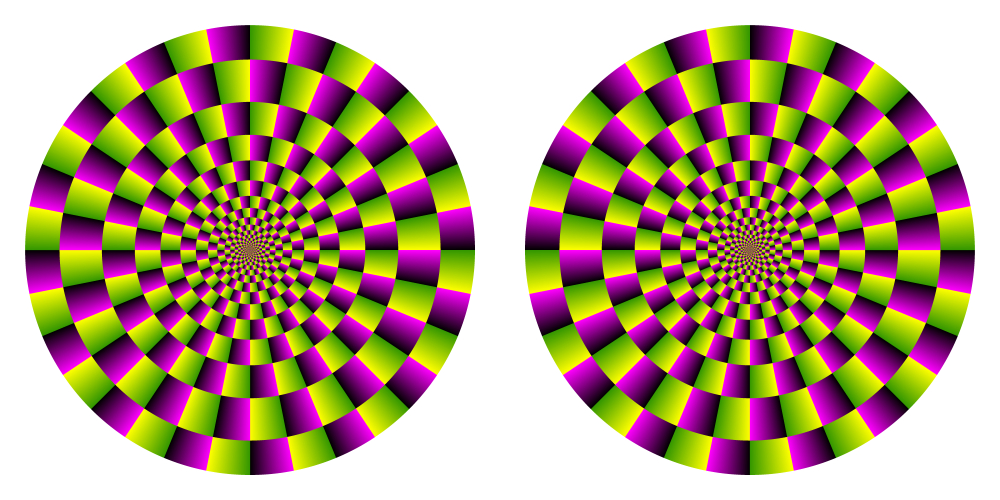
Observation 3. The illusion from dark to light is enhanced by red or blue, while the illusion from light to dark is enhanced by yellow or green. Both illusions work additively.
Optimized Fraser-Wilcox illusion の基本図形
Type I (six) 1500 x 1000
Type I (six) 6000 x 4000
Type I (six) fast type 相当 1500 x 1000
Type IIa (six) fast type 相当 6000 x 4000
Type IIa (six) 1500 x 1007
Type IIa (six) 6000 x 4031
Type IIa (six) fast type 1500 x 1000
Type IIa (six) fast type 6000 x 4000
Type IIb (six) 1500 x 1000
Type IIb (six) 6000 x 4000
Type III 1500 x 400
Type III 4500 x 1200
渦巻き錯視
Spiral illusion
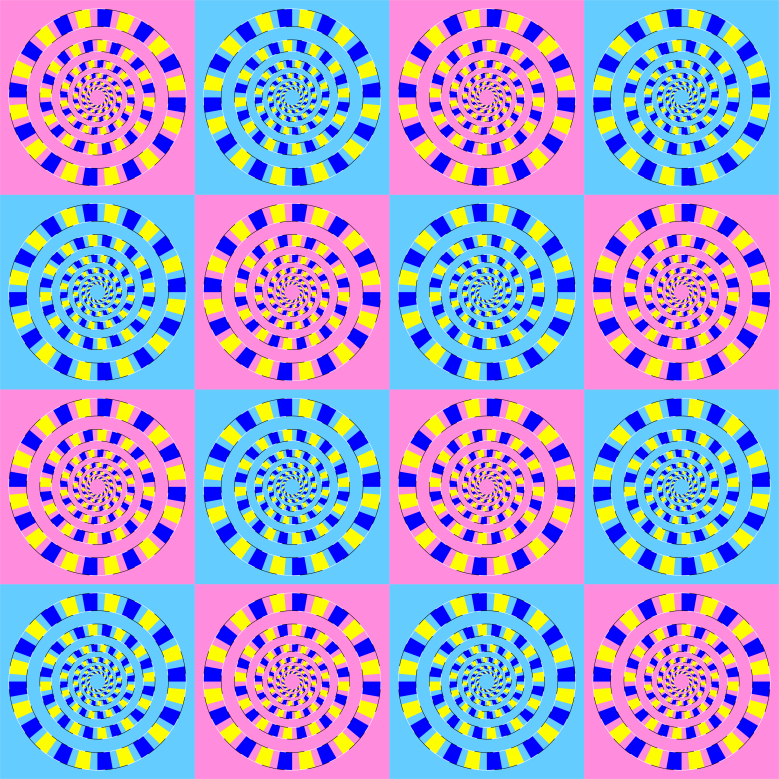
「渦巻きの詰め合わせ」
同心円のリングが渦巻きに見える。ついでに回転して見える。
Copyright Akiyoshi .Kitaoka 2006 (June 13)
Kitaoka, A., Pinna, B., and Brelstaff, G. (2001). New variations of spiral illusions. Perception, 30, 637-646. ![]()
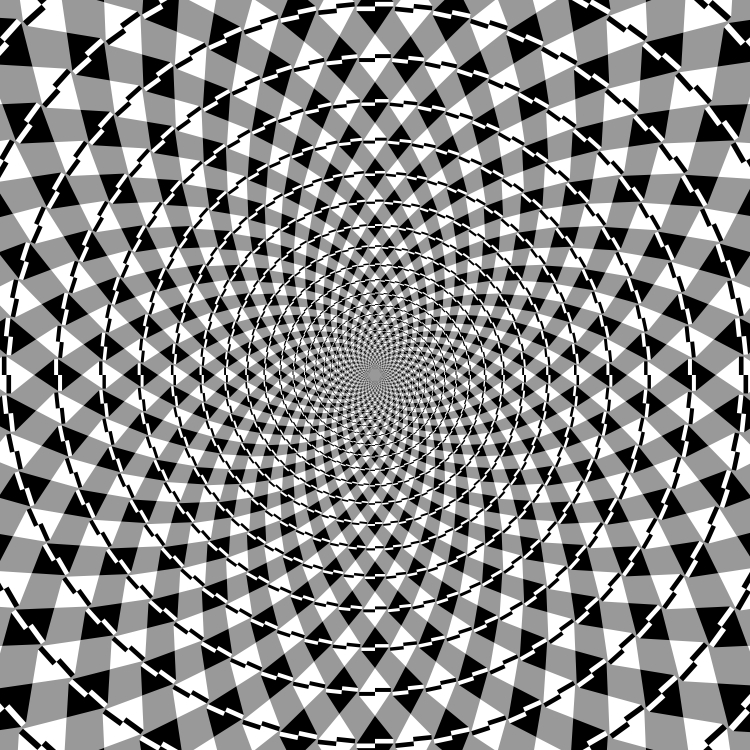
「ずれた線の錯視の渦巻き錯視(その2)の基本図形」
(フレーザー渦巻き風)
同心円が渦巻きに見える。
Copyright Akiyoshi Kitaoka 2010 (January 11)
Illusion of shifted lines
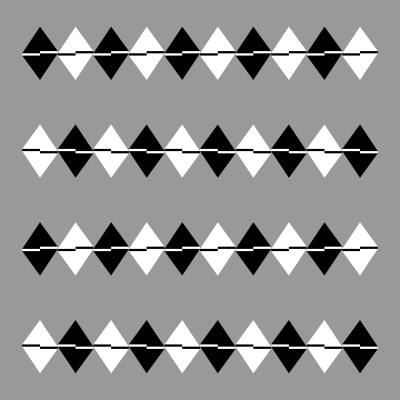
Kitaoka, A. (2007) Tilt illusions after Oyama
(1960): A review. Japanese Psychological Research, 49, 7-19. ![]() PDF
PDF
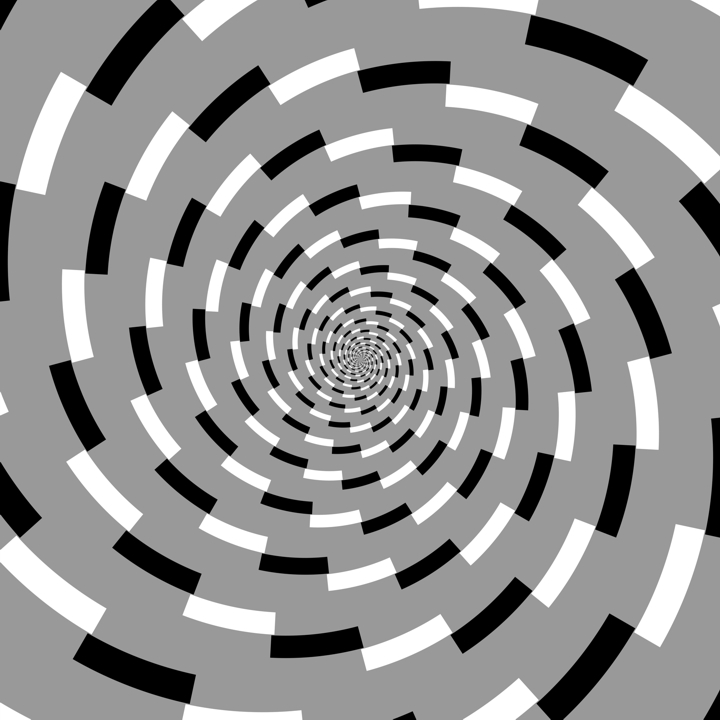
アンモナイトの化石(本物らしい・北岡蔵・2000円もした)

ちょっと地学・古生物学のお勉強

オウムガイの例 (水生生物雑記帳)

アルキメデスの螺旋
r = a・θ

描画プログラム(Spiral1a.exe) (ウインドウズ専用)
ベルヌーイの螺旋(対数螺旋あるいは等角螺旋ともいう)
r = a・exp (k・θ)
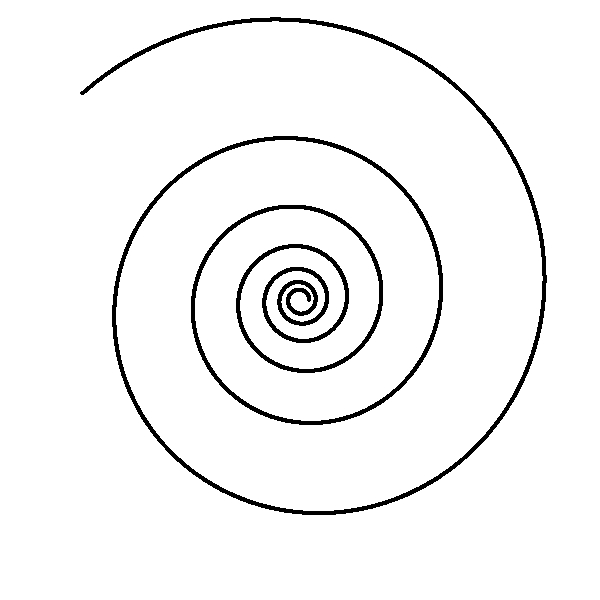
描画プログラム(Spiral1.exe) (ウインドウズ専用)
ベルヌーイの螺旋(等角螺旋)では、螺旋上のある点と中心を結ぶ線分と、その点における接線の成す角度は、すべての点において一定である。
k = 1 / tan (φ)
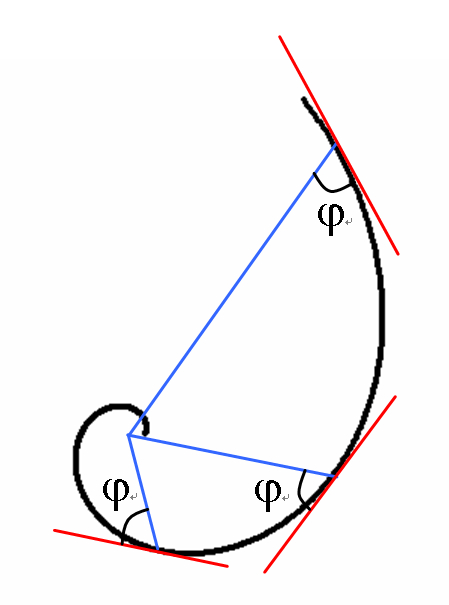
線パターンによる放射状パターン (φ = 0º)

(radial pattern)
描画プログラム(SpiralGP3b.exe)(ウインドウズ専用)
線パターンによる渦巻きパターン (φ = 65º)

(spiral pattern)
線パターンによる同心円パターン (φ = 90º)

(concentric pattern)
渦巻き錯視は、局所的な傾き錯視による渦巻き検出器の誤動作で起こると考えられる。
Kitaoka, A., Pinna, B., and Brelstaff, G. (2001). New variations of spiral illusions. Perception, 30, 637-646.
朝倉書店より、「錯視入門」まもなく発売!
詳しくはこちら
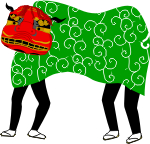 おしまい
おしまい
ご清聴ありがとうございました。

